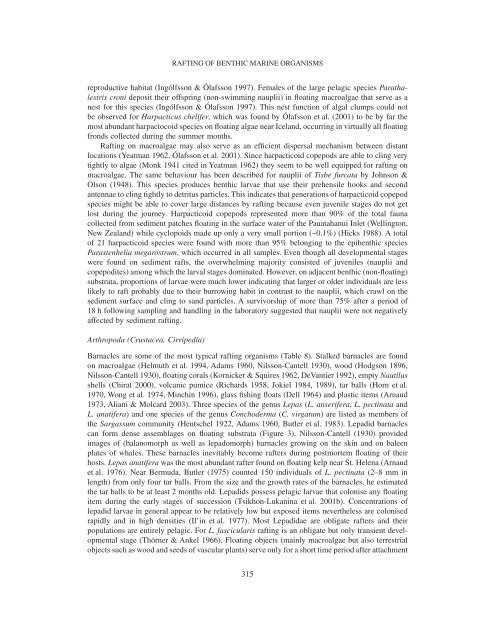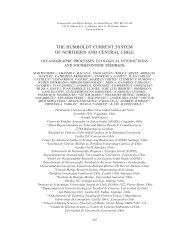The ecology of rafting in the marine environment - Bedim
The ecology of rafting in the marine environment - Bedim
The ecology of rafting in the marine environment - Bedim
You also want an ePaper? Increase the reach of your titles
YUMPU automatically turns print PDFs into web optimized ePapers that Google loves.
RAFTING OF BENTHIC MARINE ORGANISMS<br />
reproductive habitat (Ingólfsson & Ólafsson 1997). Females <strong>of</strong> <strong>the</strong> large pelagic species Parathalestris<br />
croni deposit <strong>the</strong>ir <strong>of</strong>fspr<strong>in</strong>g (non-swimm<strong>in</strong>g nauplii) <strong>in</strong> float<strong>in</strong>g macroalgae that serve as a<br />
nest for this species (Ingólfsson & Ólafsson 1997). This nest function <strong>of</strong> algal clumps could not<br />
be observed for Harpacticus chelifer, which was found by Ólafsson et al. (2001) to be by far <strong>the</strong><br />
most abundant harpactocoid species on float<strong>in</strong>g algae near Iceland, occurr<strong>in</strong>g <strong>in</strong> virtually all float<strong>in</strong>g<br />
fronds collected dur<strong>in</strong>g <strong>the</strong> summer months.<br />
Raft<strong>in</strong>g on macroalgae may also serve as an efficient dispersal mechanism between distant<br />
locations (Yeatman 1962, Ólafsson et al. 2001). S<strong>in</strong>ce harpacticoid copepods are able to cl<strong>in</strong>g very<br />
tightly to algae (Monk 1941 cited <strong>in</strong> Yeatman 1962) <strong>the</strong>y seem to be well equipped for <strong>raft<strong>in</strong>g</strong> on<br />
macroalgae. <strong>The</strong> same behaviour has been described for nauplii <strong>of</strong> Tisbe furcata by Johnson &<br />
Olson (1948). This species produces benthic larvae that use <strong>the</strong>ir prehensile hooks and second<br />
antennae to cl<strong>in</strong>g tightly to detritus particles. This <strong>in</strong>dicates that generations <strong>of</strong> harpacticoid copepod<br />
species might be able to cover large distances by <strong>raft<strong>in</strong>g</strong> because even juvenile stages do not get<br />
lost dur<strong>in</strong>g <strong>the</strong> journey. Harpacticoid copepods represented more than 90% <strong>of</strong> <strong>the</strong> total fauna<br />
collected from sediment patches float<strong>in</strong>g <strong>in</strong> <strong>the</strong> surface water <strong>of</strong> <strong>the</strong> Pauatahanui Inlet (Well<strong>in</strong>gton,<br />
New Zealand) while cyclopoids made up only a very small portion (~0.1%) (Hicks 1988). A total<br />
<strong>of</strong> 21 harpacticoid species were found with more than 95% belong<strong>in</strong>g to <strong>the</strong> epibenthic species<br />
Parastenhelia megarostrum, which occurred <strong>in</strong> all samples. Even though all developmental stages<br />
were found on sediment rafts, <strong>the</strong> overwhelm<strong>in</strong>g majority consisted <strong>of</strong> juveniles (nauplii and<br />
copepodites) among which <strong>the</strong> larval stages dom<strong>in</strong>ated. However, on adjacent benthic (non-float<strong>in</strong>g)<br />
substrata, proportions <strong>of</strong> larvae were much lower <strong>in</strong>dicat<strong>in</strong>g that larger or older <strong>in</strong>dividuals are less<br />
likely to raft probably due to <strong>the</strong>ir burrow<strong>in</strong>g habit <strong>in</strong> contrast to <strong>the</strong> nauplii, which crawl on <strong>the</strong><br />
sediment surface and cl<strong>in</strong>g to sand particles. A survivorship <strong>of</strong> more than 75% after a period <strong>of</strong><br />
18 h follow<strong>in</strong>g sampl<strong>in</strong>g and handl<strong>in</strong>g <strong>in</strong> <strong>the</strong> laboratory suggested that nauplii were not negatively<br />
affected by sediment <strong>raft<strong>in</strong>g</strong>.<br />
Arthropoda (Crustacea, Cirripedia)<br />
Barnacles are some <strong>of</strong> <strong>the</strong> most typical <strong>raft<strong>in</strong>g</strong> organisms (Table 8). Stalked barnacles are found<br />
on macroalgae (Helmuth et al. 1994, Adams 1960, Nilsson-Cantell 1930), wood (Hodgson 1896,<br />
Nilsson-Cantell 1930), float<strong>in</strong>g corals (Kornicker & Squires 1962, DeVantier 1992), empty Nautilus<br />
shells (Chirat 2000), volcanic pumice (Richards 1958, Jokiel 1984, 1989), tar balls (Horn et al.<br />
1970, Wong et al. 1974, M<strong>in</strong>ch<strong>in</strong> 1996), glass fish<strong>in</strong>g floats (Dell 1964) and plastic items (Arnaud<br />
1973, Aliani & Molcard 2003). Three species <strong>of</strong> <strong>the</strong> genus Lepas (L. anserifera, L. pect<strong>in</strong>ata and<br />
L. anatifera) and one species <strong>of</strong> <strong>the</strong> genus Conchoderma (C. virgatum) are listed as members <strong>of</strong><br />
<strong>the</strong> Sargassum community (Hentschel 1922, Adams 1960, Butler et al. 1983). Lepadid barnacles<br />
can form dense assemblages on float<strong>in</strong>g substrata (Figure 3). Nilsson-Cantell (1930) provided<br />
images <strong>of</strong> (balanomorph as well as lepadomorph) barnacles grow<strong>in</strong>g on <strong>the</strong> sk<strong>in</strong> and on baleen<br />
plates <strong>of</strong> whales. <strong>The</strong>se barnacles <strong>in</strong>evitably become rafters dur<strong>in</strong>g postmortem float<strong>in</strong>g <strong>of</strong> <strong>the</strong>ir<br />
hosts. Lepas anatifera was <strong>the</strong> most abundant rafter found on float<strong>in</strong>g kelp near St. Helena (Arnaud<br />
et al. 1976). Near Bermuda, Butler (1975) counted 150 <strong>in</strong>dividuals <strong>of</strong> L. pect<strong>in</strong>ata (2–8 mm <strong>in</strong><br />
length) from only four tar balls. From <strong>the</strong> size and <strong>the</strong> growth rates <strong>of</strong> <strong>the</strong> barnacles, he estimated<br />
<strong>the</strong> tar balls to be at least 2 months old. Lepadids possess pelagic larvae that colonise any float<strong>in</strong>g<br />
item dur<strong>in</strong>g <strong>the</strong> early stages <strong>of</strong> succession (Tsikhon-Lukan<strong>in</strong>a et al. 2001b). Concentrations <strong>of</strong><br />
lepadid larvae <strong>in</strong> general appear to be relatively low but exposed items never<strong>the</strong>less are colonised<br />
rapidly and <strong>in</strong> high densities (Il’<strong>in</strong> et al. 1977). Most Lepadidae are obligate rafters and <strong>the</strong>ir<br />
populations are entirely pelagic. For L. fascicularis <strong>raft<strong>in</strong>g</strong> is an obligate but only transient developmental<br />
stage (Thörner & Ankel 1966). Float<strong>in</strong>g objects (ma<strong>in</strong>ly macroalgae but also terrestrial<br />
objects such as wood and seeds <strong>of</strong> vascular plants) serve only for a short time period after attachment<br />
315










